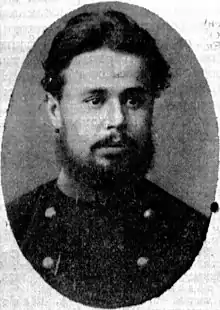Supreme Court of the Soviet Union
The Supreme Court of the Soviet Union (Russian: Верховный Суд СССР) was the highest court of the Soviet Union during its existence. It was established on November 23, 1923 and was dissolved on January 2, 1992.[1] The Supreme Court of the USSR included a Military Collegium and other elements which were not typical of supreme courts found in other countries, then or now.[2] The first chairman of the Supreme Court was Nikolai Krylenko.
| Politics of the Soviet Union |
|---|
.svg.png.webp) |
|
|
History
Lenin Era
When the Soviet legal system was established, it was intended to serve the proleteriat Soviet through the Communist Party. In order to assure this would be the case, the Communist Party packed the courts with its own members. Complications arose from this as they lacked legal experience, and thus led to a large number of appeals. The USSR Supreme Court played little role in legal affairs as the 1924 Constitution of the Soviet Union meant that appeals from the Soviet Republic courts could not be appealed. The USSR Supreme Court was limited to cases from military tribunals. Republic courts could issue policy directives, whereas the USSR Supreme Court could only do so in relation to Soviet law.[3]
The primary role of the USSR Supreme Court was constitutional review. The USSR Supreme Court assesed Republic law to ensure consistency with Soviet law, at the request of Central Executive Committee of the Soviet Union. It was mostly advisory as it was the function of the Central Executive Committee to act upon the court's interpretation.[3]
Stalin Era
In 1929, the constitutional activity of the Supreme Court ended. Stalin's Collectivisation programs led to the simplification of the legal system and legal norms. Courts were expected to serve political goals. The attention of the USSR Supreme Court was directed towards monitering lower courts. In 1934, the USSR Supreme Court gained the legal authority to issue instructions, obtain reports, and conduct surveys of lower courts.[3]
During Stalin's Purges, charges were brought in various courts, including provincial courts, Republic Courts and the USSR Supreme Court. Eventually, in 1938 almost all members of the USSR Supreme Court were purged, most of whom were sent to labor camps. Stalin installed new judges in the USSR Supreme Court and were given significantly more power under the 1936 Constitution of the Soviet Union. The USSR Supreme Court was empowered to examine provincial court cases, thus bypassing Republic Supreme Courts.[3]
Post-Stalin Era
During De-Stalinization, Soviet criminal law from the Stalin Era was removed. This includes, labor infractions, abortion, and petty theft being decriminalised. In 1957, Khrushchev with an agenda of decentralisation in relation to governmental authority, eliminated the jurisdiction the USSR Supreme Court had over other courts. Later in 1962, the court instituted a Scientific Advisory Council, which introduced legal scholars into the process of formulating judicial directives as consultants.[3]
Gorbachev Era
Gorbachev's policies of reform allowed for the press and jurists to expose the abuses in the Soviet administration of justice. This was to also to start a movement for judicial reform. The USSR Supreme Court contributed to the legitimisation of Gorbachev's reforms, not just purely in justice, as it played a role in reintroducing the arts that Stalin once repressed. Additionally, political leaders whom were initially purged or condemned by the Soviet Union, were revived by Supreme Court investigations. Most notebally, it found that Bukharin's trial was no longer law. From 1985 to 1987, the USSR Supreme Court rehabilitated 240 people from the Stalin Era.[3]
It was proposed that the constitutional functions of the USSR Supreme Court would be returned, chiefly in relation to the instructions and directives of bureaucratic agencies. This was not a new idea, as it was previously in discussion for the 1977 Constitution of the Soviet Union.[3]
Chairmen
| No. | Portrait | Name | Took office | Left office | Time in office |
|---|---|---|---|---|---|
| 1 | Nikolai Krylenko (1885–1938) | 28 November 1923 | 2 February 1924 | 66 days | |
| 2 | Alexander Vinokurov (1869–1944) | 11 January 1924 | 17 August 1938 | 14 years, 218 days | |
| 3 | Ivan Golyakov (1888–1961) | 17 August 1938 | 25 August 1948 | 10 years, 8 days | |
| 4 | Anatoly Volin (1903–2007) | 25 August 1948 | 12 February 1957 | 8 years, 171 days | |
| 5 | Alexander Gorkin (1897–1988) | 12 February 1957 | 20 September 1972 | 15 years, 221 days | |
| 6 | Lev Smirnov (1911–1986) | 20 September 1972 | 12 April 1984 | 11 years, 205 days | |
| 7 | Vladimir Terebilov (1916–2004) | 23 April 1984 | 12 April 1989 | 4 years, 354 days | |
| 8 | Evgeniy Smolentsev (1923–2017) | 7 June 1989 | 2 January 1992 | 2 years, 209 days |
See also
References
- Text of the order on the dissolution of the Supreme Court (Russian)
- ""On the abolition of the Supreme Court of the USSR, the Supreme Arbitration Court of the USSR and the Prosecutor's Office of the USSR"".
- Solomon, Peter H. (1990). "The U. S. S. R. Supreme Court: History, Role, and Future Prospects". The American Journal of Comparative Law. 38 (1): 127–142. doi:10.2307/840257. ISSN 0002-919X.



